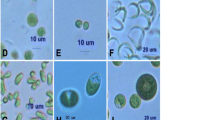Abstract
Two microalgae species (Scenedesmus obliquus and Neochloris oleoabundans) were cultivated in closed sleeve photobioreactors in order to select the best oil producer for further large-scale open raceway pond cultivations, aiming at biofuel production. Scenedesmus obliquus reached a higher maximum biomass concentration (1.41 g l−1) with a lower lipid content (12.8% w/w), as compared to N. oleoabundans [maximum biomass concentration of 0.92 g l−1 with 16.5% (w/w) lipid content]. Both microalgae showed adequate fatty acid composition and iodine values as substitutes for diesel fuel. Based on these results, N. oleoabundans was selected for further open raceway pond cultivations. Under these conditions, N. oleoabundans reached a maximum biomass concentration of 2.8 g l−1 with 11% (w/w) of lipid content. A high correlation between the Nile Red fluorescence intensity measured by flow cytometry and total lipid content assayed by the traditional gravimetric lipid analysis was found for both microalgae, making this method a suitable and quick technique for the screening of microalgae strains for lipid production and optimization of biofuel production bioprocesses. Medium growth optimization for enhancement of microalgal oil production is now in progress.





Similar content being viewed by others
References
Ma, F. R., & Hanna, M. A. (1999). Bioresource Technology, 70, 1–15. doi:10.1016/S0960-8524(99)00025-5.
Patil, V. (2008). Current Science, 92, 707.
Chisti, Y. (2007). Biotechnology Advances, 25, 294–306. doi:10.1016/j.biotechadv.2007.02.001.
Bligh, E. G., & Dyer, W. J. (1959). Journal of Biochemistry and Physiology, 37, 911–917.
Miao, X., & Wu, Q. (2006). Bioresource Technology, 97, 841–846. doi:10.1016/j.biortech.2005.04.008.
Elsey, D., Jameson, D., Raleigh, B., & Cooney, M. J. (2007). Fluorescent measurement of microalgal neutral lipids. Journal of Microbiological Methods, 68, 639–642. doi:10.1016/j.mimet.2006.11.008.
de la Jara, A., Medonza, H., Martel, A., Molina, C., Nordströn, L., de la Rosa, V., & Díaz, R. (2003). Journal of Applied Phycology, 15, 433–438. doi:10.1023/A:1026007902078.
Fowler, S. D., Brown, W. J., Warfel, J., & Greenspan, P. (1979). Journal of Lipid Research, 28, 1225–1232.
Greenspan, P., Mayer, E. P., & Fowler, S. D. (1985). The Journal of Cell Biology, 100, 965–973. doi:10.1083/jcb.100.3.965.
Pulz, O. (2001). Applied Microbiology and Biotechnology, 57, 287–293. doi:10.1007/s002530100702.
Tornabene, T. G. (1983). Enzyme and Microbial Technology, 5, 435–440. doi:10.1016/0141-0229(83)90026-1.
Sheehan, J., Dunahay, T., Benemann, J., & Roessler, P. (1998). A look back at the US Department of Energy’s Aquatic Species Program—Biodiesel from Algae. National Renewable Energy Laboratory, Golden, Colorado, USA.
Bourrelly, P. (1972). Les algues vertes. Tome I, Editions N. Boubée & Cie, Paris.
Bold, H. C. (1949). Bulletin of the Torrey Botanical Club, 76, 101–108. doi:10.2307/2482218.
European Standard EN ISO 5509 (2000).
European Standard EN 14214 (2003).
da Silva, T. L., & Reis, A. (2008). Journal of Industrial Microbiology & Biotechnology, 35, 875–887.
Yeung, P. K. K., & Wong, J. T. Y. (2003). Protoplasma, 220, 173–178. doi:10.1007/s00709-002-0039-2.
Richmond (1986). Handbook of microalgal mass culture. Boca Raton: CRC.
Choi, K. J., Kakhost, Z., Barzana, E., & Karel, M. (1987). Food Technology, 11, 117–128.
Zhukova, N. V., & Titlyanov, E. A. (2006). Botanica Marina, 49, 339–346. doi:10.1515/BOT.2006.041.
Xu, H., Miao, X., & Wu, Q. (2006). Journal of Biotechnology, 126, 499–507. doi:10.1016/j.jbiotec.2006.05.002.
Nalewajko, C., & Voltolina, D. (1985). Canadian Journal of Fisheries and Aquatic Sciences, 43, 1163–1170.
Chisti, Y. (2008). Trends in Biotechnology, 26, 351–352. doi:10.1016/j.tibtech.2008.04.002.
Acknowledgements
The authors wish to acknowledge Doutora Narcisa Bandarra from IPIMAR for the fatty acid analysis.
Author information
Authors and Affiliations
Corresponding author
Rights and permissions
About this article
Cite this article
da Silva, T.L., Reis, A., Medeiros, R. et al. Oil Production Towards Biofuel from Autotrophic Microalgae Semicontinuous Cultivations Monitorized by Flow Cytometry. Appl Biochem Biotechnol 159, 568–578 (2009). https://doi.org/10.1007/s12010-008-8443-5
Received:
Accepted:
Published:
Issue Date:
DOI: https://doi.org/10.1007/s12010-008-8443-5




